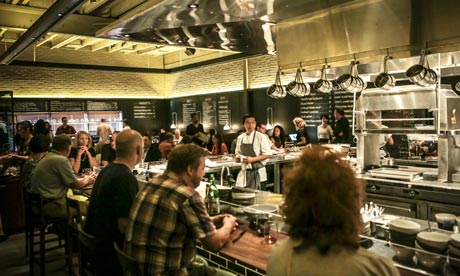
On July 4 1776, the founding fathers of America gathered in Philadelphia to declare their independence from (no offence, English readers) the tyranny of English rule. You can still visit the site of this pivotal moment in American history: Independence Hall, a colonial building in the Old City neighbourhood, where Benjamin Franklin impersonators direct chattering tour groups, and carriage-hitched horses clickety-clack down the cobblestoned streets. It is the second most interesting thing in this handsomely preserved district. The first is a restaurant called Fork.
Businesses like Fork jump-started the area's renaissance. Many of us who grew up in Philadelphia remember the Old City of the not-too-distant past, when derelict buildings formed a coal necklace around the city's historical gems. But Fork – a light-filled, amber enclave with high ceilings and an open kitchen – changed how Philadelphians dined when it opened in 1997. It is doing so again, with a new chef, Eli Kulp, who is currently cooking some of the city's most fascinating food.
Kulp infuses gnudi (gnocchi made from ricotta cheese and a little bit of flour) with lavender, turns whole Muscovy ducks into feasts worthy of a Peking dynasty, and bakes incredible sponge-like, squid-ink bread that looks like something you'd find while scuba diving in the Seychelles. His big goal this year is to start a snail farm, but first he'll replace Fork's adjacent grocery with High Street on Market, a cafe serving gutsy sandwiches by day and hyper-creative dinners at night.
Formerly the chef of the trendsetting Torrisi Italian Specialties in Manhattan, Kulp is part of a recent wave of acclaimed chefs who've moved from New York to start a new life in the city that has long lived in the Big Apple's shadow. His fellow expats can be found captaining Philly's hottest restaurants: Serpico, former Momofuku chief Peter Serpico's solo smash, and Vernick Food + Drink, a two-storey dining room in ritzy Rittenhouse Square from Gregory Vernick, a veteran of Jean-Georges Vongerichten.
The new cooks on the block are discovering what homegrown chefs such as Marc Vetri, authority on Italian cooking and owner of five restaurants, including Pizzeria Vetrihave known for a long time: Philly's easy-going pace, small-town vibe and affordability make it a great place to live – and eat. Immigrants, whether from New York or much further afield, have always been the reason for this.
Follow the hypnotic perfume of star anise and roasted beef bones down to Washington Avenue in South Philly, a thoroughfare that should be renamed Pho Boulevard. People from Vietnam settled here in the 1980s and 90s, an influx that gave rise to hybrid French bakeries such as Ba Le (606 Washington Avenue) and noodle parlours like Pho 75 (1122 Washington Avenue). These are places where you might bump into Michael Solomonov, chef of the sterling Israeli restaurant Zahav). The Vietnamese community has made the strongest and most delicious mark on the local food scene since the Italians of the 1920s.
Thousands traded southern Italy for South Philly, and established businesses along 9th Street (now known as the Italian Market) and Passyunk Avenue (always known as "Pa-shunk" Avenue) in the early 1900s. Some linger on the latter: pungent delis such as Mancuso's (1902 East Passyunk Avenue), where mozzarella balls bob in bins of cloudy saltwater, and Marra's, whose 90-year-old pizza ovens are said to be built with bricks of Vesuvian stone.
Today, the Avenue is less spaghetti and more taccozzelle and 'nduja, thanks to enterprising indie restaurants like Le Virtu, while the gelato, courtesy of Capogiro, comes in flavours like Dark & Stormy and Saigon cinnamon.
On the north side of town, near the Delaware river, the Irish pubs and Polish clubs of close-knit Fishtown and Port Richmond now co-exist with craft-beer oases like Memphis Taproom and cantinas like Loco Pez, beloved by residents for its frequent dollar-taco nights.
Recover at Mercer cafe, a sunny luncheonette that makes Philly's butteryest cream-chipped beef, a stick-to-your-ribs breakfast of creamy beef gravy heaped over toast. If you want to blend in with the local policemen and art school dropouts who hang here, ask for the dish by its affectionate nickname, SOS, or shit on a shingle.
Back in South Philly, fragrant coconut soups simmering at Sky Cafe sustain a burgeoning Indonesian population, while newcomers from the central Mexican state of Puebla continue to move here en masse, bringing tacos al pastor and agua de tamarindo, working, like Luis Jimenez, anonymously in restaurant kitchens till they can afford spaces of their own. Los Gallos, a cheerful taqueria draped in banners and flags, like a beauty pageant contestant, is the fruit of Jimenez's labour, now three years old and serving the best Mexican food in town. It's the American dream, or at least the Philadelphia one.
Adam Erace, Philadelphia-based food and travel writer. He blogs at adamerace.tumblr.com.You can follow him on Twitter @adamerace
• For more information on holidays in the USA, visit DiscoverAmerica.com

